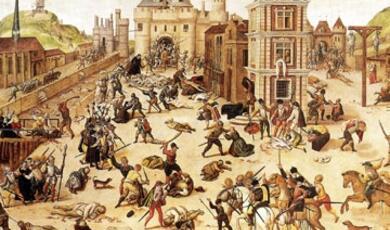English Architecture and the First World War
Share
- Details
- Transcript
- Audio
- Downloads
- Extra Reading
The First World War had a devastating effect on Britain. Human and economic loss was accompanied by a loss of confidence and direction. This lecture looks at both the cultural effects of the War and its architectural impact. Both saw a struggle to reconcile a rejection of the pre-war world and a longing for it.
This is a part of the lecture series, English Architecture: Into the Modern World.
Simon Thurley’s four lectures complete his survey of English building from the Saxons to the present day. The theme is modernity and tradition. This is the story of how British architects struggled to find an architectural language that met the needs and aspirations of a society in a state of rapid change while negotiating deep and popular traditions and beliefs. Two World Wars shook the nation producing the seemingly contradictory emotions of nostalgia and progress. Out of this has come the world in which we live.
The other lectures in this series are as follows:
Building the Victoria City: Splendour and Squalor
Forwards and Backwards: Architecture in inter-war England
Coming to Terms with Modern Times: English architecture in the post-war era
Download Transcript
14 November 2012
English Architecture and the
First World War
Dr Simon Thurley
Tonight I am going to take a slightly different tack to most of my previous lectures.
When war broke out with Germany in 1914 the last major European Conflict that Britain had experienced had been almost exactly a hundred years before. The defeat of Napoleon at Waterloo in 1815 had ended Britain’s military engagement in Europe for a century. In fact since 1871 there had been no war between major European Powers and so nobody quite knew what this new war would be like. Those with imagination and responsibility for the preparations imagined troops marching to a series of great set piece battles where the outcome would be rapidly decided.
Mustering the troops for this new conflict also followed traditional lines. During the Crimean war the government had been forced to rely on the historic county and town militias to boost regular troops in the field. This exposed Britain’s lack of military capacity and led to the fear that if Britain were sucked into the Second Italian War of Independence that had broken out between France and Austrian Empire in 1858 it would not be able to cope. So in 1859 a new Volunteer Rife Corps was established to defend coastal towns and harass an invading enemy. After 1862, these bands became increasingly centralised and more closely aligned with the regular army, until 1907 when they were reconstituted as the Territorial Army.
From the 1860s these volunteer bands built themselves drill halls in which to train. In all as many as 1,800 of these structures were built across England, normally paid for by their members of through local fundraising. The most obvious characteristic of these buildings was their large central halls which were normally around 100ft long and perhaps 50-60ft wide used for marching and weapons practice. My photograph is probably of the County of London Battery’s hall in Sheppard’s Bush. Some of the larger ones had a library or billiard room attached for social occasions and many had an attached house where a caretaker would live.
This is the Drill Hall in Northampton Hall a large an imposing HQ built around 1880. The Tudor Military style was popular and felt to be appropriate to many of these buildings. Here is the large and showy hall in Lincoln built at a cost of £10,000 and paid for by City industrialist and MP Joseph Ruston. It was completed in 1890 to the design of Goddard and Son. As well as the main hall it also had, amongst other facilities, a men’s club, firing range, armoury and gymnasium. Many were much smaller such as this (now demolished) red brick hall in Stourbridge, Worcestershire.
On the outbreak of the First World War on 4 August 1914 there was a rush to sign up and it was to these Victorian and Edwardian Drill Halls that men reported. All these men had to receive basic training before being sent abroad, and it soon became clear that preparation in one particular type of combat was paramount: trench warfare. Several systems of practice trenches survive, although generally they can only be seen from the air. They were normally built in existing military training areas such as Salisbury Plain as seen here at Beacon Hill, Bulford. Or sometimes on other government land. This is Redmires, on the western side of Sheffield, where the 1,100-strong Sheffield Pals’ battalion trained: here are full-scale trenches, crawl trenches, and miniature trench models. The trenches at Barham, Kent Survive as soil marks, but here are men training in the use of field telephones. Many of these places turned into huge encampments. Many thousands of men had to be accommodated at these sites, some like these men from a London Territorial regiment were billeted in bell tents like this. The photograph is from 1914 at larkhill near Stonehenge. Later thousands of tin huts were built such as these also at larkhill, in 1915.
In the earliest stages of the war, the Imperial German Navy tried to lure the British Navy into destructive battle by bombarding the British coast. On 16 December 1914 Scarborough and Whitby were shelled [with Scarboro’s Grand Hotel and Castle, and Whitby Abbey being scarred], and more damagingly Hartlepool, at which a thousand rounds were hurled. Here 86 people were killed and over 400 injured: for a time, ‘Remember Scarborough’ replaced ‘Remember Belgium’ on recruiting posters.
The failure of the Neuve Chapelle offensive in May 1915 was blamed on the ‘shell shortage’ scandal: too few shells, and too many of them duds. The Liberal government was brought down, and the new coalition passed an Act which brought all armaments manufacture under a Ministry of Munitions. By 1918 this managed directly 250 government factories, and supervised 20,000 more.
Rotherwas was one of the new National Factories: a 500-acre site devoted to filling shells with picric acid and Amatol, and in the last months of the war mustard gas. Here is one of the picric acid stores – a very rare survival as most WWI Factories have now gone. As industrial production stepped up, and as ever-more men were combed out for active service, almost 600,000 women became munitioneers at Rotherwas, and here at Woolwich Arsenal filling shells and manufacturing war-hardware. Here in the English Heritage Archive in Swindon is a rare photograph showing shell-filling in 1917 at the Cunard works in Birkenhead. The work was relatively well paid, but risky; many women were slowly poisoned by the chemicals they worked with, and others died in explosions. The biggest, in 1916, at a factory at Faversham, killed 108 workers who lie in a mass grave, now as listed structure.
Factories were not just taken over willy-nilly; generally particular tasks were allocated to areas where particular skills had grown up. So for instance in Lancaster, the celebrated furniture maker Waring & Gillow’s factory of the 1880s was turned over to bi-plane manufacture.
Prosecuting the war was, of course, cripplingly expensive, and the government appealed to the public, as a patriotic duty, to take out war savings and bonds. Novel promotions included the so-called ‘tank banks’ – tanks which toured the country in 1917-18 to raise support for saving. At the war’s end, 264 of the most generous boroughs were presented with a battle-scarred tank, usually displayed in a public park or open space, as here at Deal. Many went for scrap in the Second World War, and today only that at Ashford, in Kent, survives – probably because it was used as an electricity sub-station from 1929.
One reason why tanks were used in this way was presumably because they were novel, and would draw crowds. Another demonstration, not least to the civilian population, that this was a war which was being fought in an entirely new way, came with air raids. England became the first country in the world to sustain major civilian damage from aerial bombardment.
The first Zeppelin raids, on the east coast and then London, took place in January 1915, and continued into the summer: there were 20 raids in all, resulting in more than 500 killed and over 1,300 wounded. Here is bomb damage in Hull. Anti-aircraft defences were almost wholly ineffectual, and this led to a shake-up in 1916: more anti-aircraft guns, more searchlights, and ten home fighter squadrons with new ammunition including tracer. Finally, on the night of 2 September 1916 a Zeppelin was shot down, and although attacks continued into 1917 the Zeppelin’s days were numbered.
Instead, in May 1917 heavy Gotha bombers started to lumber over the Channel on daylight bombing raids, shifting to night raids in September of that year – in the first Cleopatra’s Needle was peppered with shrapnel. Gotha raids, which killed markedly more than the Zepplins had, continued throughout the winter - this bomb damage on a listed building in the Inns of Court resulted from a raid on 18 December. The final raid came on the night of 19 May 1918 when 41 planes attacked London; 72 bombs were dropped, but six planes were brought down by air defences. This was the last attack on mainland Britain until the Blitz.
Other reminders of London’s first, and forgotten, blitz are various memorials. There is one in Cuffley, Herfordshire to mark the spot where Lieutenant William Leefe Robinson achieved the first successful downing of an airship, in September 1916, for which he was awarded the VC. Another not far from here is to 18 children killed in North Street School, Poplar, during the first Gotha raid on London, in June 1917.
Anti-aircraft defences, and indeed the effective military use of aircraft, had been in their infancy at the start of the war. 1912 proved a formative year: The Royal Flying Corps was founded, and two batteries of anti-aircraft defences – the first in the world - were planned for the Hoo Peninsula in Kent, overlooking northwards across the Thames Estuary, to offer protection against Zeppelin attacks on the Royal Navy’s ordnance depots upriver. By January 1913 construction had started, and over the next year two three-inch guns were installed at each, alongside barracks and other facilities for 35-man establishments.
Once the war started, the RFC rapidly expanded, with new squadrons, new aerodromes – 250 by the war’s end - and ever-more and faster planes. This rapid evolution, and the re-use of so many sites in the Second World War, means that relatively few sites retain the spirit and feel of the pioneer days of air warfare. One that does is the remarkable Stow Maries in Essex, from which sorties were flown in July 1917 against Gotha bombers as they launched their first attacks on London. Abandoned in 1918, other than its hangers, it is essentially complete, and has recently won a big heritage prize for its restoration.
Hangers, three massive double-span affairs, do survive at at Duxford, in Cambridgeshire, which has one of the few other significant groups of First World War aerodrome buildings. Built in 1917-18 (by German POWs) each hanger accommodated an RFC training airfield squadron. Here and there further buildings survive which were relocated to new sites, typically at the war’s end when surplus to requirements. This rare seaplane hanger, of about 1918, was moved in the early 1920s from the Newhaven Seaplane Station to a railway yard in Wimbledon, where it remains in use.
Another response to the German air offensive, alongside fighter squadrons and ack-ack, was sound mirrors, built from 1916 onwards on the south and north-east coasts of England. Simple in conception, with the concave mirror reflecting sound to a central microphone, on a good day they could pick up incoming aircraft up to 15 miles out. Bad weather reduced their efficacy, as did ever-faster aircraft. This, at Namey Hill, Sunderland, is one of four First-War examples which survive from the chain which stretched from the Humber to the Tyne.
None of this was great architecture. It was an immediate response to an overwhelming national crisis; but it brought a war, otherwise fought entirely overseas, into the forefront of people’s experience. It also introduced new building types, new inventions and new ways of thinking about organising people and processes. Just before I go on to look at what this meant for architecture in post war England I want to briefly turn to commemoration.
Taking the British Empire overall, very roughly 9 million men were mobilized over the course of the war; of these a million were killed and 2 million wounded. In March 1915, as a result of direct pressure from the Graves Registration Commission (later the Commonwealth War Graves Commission), repatriation of bodies to England was banned as the idea and design of government-sponsored war cemeteries was rapidly formalised. Thus it is the great majority of CWGC cemeteries lie abroad, where men fell. But across England there are large numbers of graves, and some cemeteries, the resting place of servicemen and women who died of wounds, illness or mishap while training.
Brookwood, near Bagshot, is the largest, the British and American cemeteries being established as separate zones in 1917 within the pre-existing cemetery. It was extended in the Second War with further national military burial grounds (to 37 acres). There is a German Cemetery on Cannock Chase. German personnel from the First War lie alongside those from the Second. Equally striking in its empathetic design is the small Muslim Burial Ground, established near Woking in 1917 for Indian Army soldiers who died of their wounds while in England. (Now empty of its war dead – translated to Brookwood in 1968).
Other memorials to those who served, and fell, are typically more local: there may be as many as 100,000 in England. They come in all shapes and sizes and of many types. Here is the Corporate memorial that I pass most days. It is in the middle of the Prudential Insurance Company headquarters in Holborn. It was designed by F.V. Blundstone (1922). Here is a typical community memorial in Bridgnorth but with rather a good sculpture on top - 1920 Adrian Jones. Other memorials were intended to benefit the community: Village Halls, playing fields, and in the case of Oundle School a chapel, designed by A.C. Blomfield, where the 222 staff and pupils who number among the Fallen are remembered.
The First World War had a huge impact on English society. It also had a huge impact on the social policy of successive post war governments. The scale and the intensity of the conflict involved more-or-less the whole population and, as the resources to wage all-out war required greater and greater sacrifices, the commitment of the government to make social reforms afterwards became part of a sort of unwritten social contract. In other words as the war progressed it was only possible to continue to fight if there was the prospect of a better world for its returning survivors.
At the centre of this was housing policy. To quote Walter Long, the President of the Local Government Board ‘To let them come home from the horrible, water-logged trenches to something little better than a pigsty here would, indeed be criminal… and a negation of all that we have said during the war, that we can never repay those men for what they have done for us’.
We saw in my last lecture how gradually the worst Victorian slums were being replaced and improved by a combination of legislation, technology and landlord responsibility. But the big realisation after the First World War was that private enterprise would not and could not bring about changes in the quality and quantity of housing stock fast enough. By 1918 it had become accepted that it would be necessary to use central government finance to subsidise local authority house building schemes. In 1918 there were probably 600,000 houses too few In England and by 1921 the number was a little over 800,000.
Put simply this meant that many returning servicemen returned to a situation worse than they had left, being forced to move in with their parents or in-laws. Many occupied temporary accommodation like railway carriages. Private investors were not building new rented accommodation as rents had been legally capped in 1915 at 1914 levels. There was simply no money in speculative rented housing for investors.
I won’t spend time this evening on the plethora of Committees, acts and regulations between 1918 and 1925; I want to concentrate on what was different - what had changed. Well, the first point is that before the war it had been the middle classes that had moved out of the city centres to create suburbia. After 1919 the decision to build new houses on the principles of the garden city meant that most new working class housing would be far from the city centres where the old crowded and discredited houses had been.
Probably the most spectacular example of this is the work undertaken by the London County Council which built huge estates outside what was then London in areas of former farmland. The largest of these was the Becontree Estate which you see here under construction in 1927. It was built on open land and farms were bulldozed to make way for the new houses. The Estate was begun in 1921 and was designed as a cottage garden estate, where parks, gardens and green spaces were as important as houses. Over 300 acres of land were compulsorily purchased in Dagenham, Ilford and Barking. A 500-foot jetty was built on the Thames so that building materials could be brought in by barge. It took over ten years to build and was by then the largest estate in the world. Its 27,000 houses provided new homes for over 100,000 people. They were intended for the better-off working class Londoner and most were large –two thirds of interwar council houses had three bedrooms. All were fitted with gas and electricity, inside WCs, fitted baths and front and back gardens.
In this way between 1919 and 1939 England gained 4 million new houses, 1.5m of which were state subsidised. This was an astonishing change. By the eve of the Second War 30% of all English houses were new, and new with vastly improved size and facilities. This, of course transformed the lives of millions of people. One of the big characteristics for men, in particular, was that they no longer lived close to where they worked. It now became necessary to commute. There was a massive explosion of busses and bus routes after the war, but the construction of new housing was accompanied by the extension of the rail network, particularly the underground. Indeed some rail companies, such as the Metropolitan, became property developers too. They built ten estates along their new line to Uxbridge and Amersham. This is the Weller Estate at Amersham one of the Met’s investments of the 1930s. They had purchased the land in 1930 for £18,000 and by the outbreak of World War II 535 semi detached houses had been built to be sold at £875 upwards.
The Metropolitan Line was still a separate enterprise but most of the other underground lines owned by the Underground Group were extended to meet the massive growth. The Central Line was extended to Ealing in 1920, The Northern Line to Edgware and Morden in 1922-4 and the Piccadilly Line to Cockfosters, Uxbridge and Hounslow 1932-3. The Managing Director of the Underground was Frank Pick, an able and imaginative man who wanted to give the new stations a recognisable corporate design style. His architect was Charles Holden and he and Pick went on a European a research trip in 1930 to crystallise their ideas. They were particularly struck by the work of contemporary Dutch and Swedish architects and their influence can be seen in his station designs. Sudbury Station was the prototype for what Holden called his ‘brick boxes with concrete lids’. Here you can see all the elements that were to appear in his later stations – extended vertical and horizontal lines, red brick with smooth concrete, metal window frames and glazed tiles. Sometimes a tower was added, or a drum as at Arnos Grove. The interiors were sleek, modern, but simple and less expensive than they looked relying of standardised and mass produced materials. This is the foot of the escalators at Arnos Grove. Holden was very aware of how light should be used and aware that the stations had to be seen, and look good at night.
Holden’s stations clearly looked very different from underground stations, and most other buildings before the war. They were cleaner, more geometrical, and sculptural even. His massive new headquarters for London Underground over St. James’s Park Station was a modern building but not a modernist one in a stylistic sense. Now, what do I mean by that? Modernism is another one of those terrible art-historical terms that mean everything and nothing. Architecturally it is associated with a movement that started in Germany in the late nineteenth century that rejected revivalism, classicism and eclecticism in architecture and sought a new style built on the capabilities of new materials, steel, glass and concrete. In practice this led to a concentration on only expressing function and turning away from ornament.
Holden’s buildings cannot be said to do these things wholeheartedly, indeed they were extensions of the classical tradition, 55 Broadway sits happily in a long tradition of English domestic and commercial buildings. This really characterises the style of the interwar years in England. There were some modern movement buildings, private houses, exhibition buildings and some factories, but they were in a minority. English architecture between the wars remained rooted in traditional styles, especially in variants of classical architecture.
Just to make this point, let’s look at a couple of buildings which do turn their back on traditional and historical styles. Perhaps the earliest of these was an exhibition building, The Royal Horticultural Society New Hall designed by Howard Robertson and John Murray Easton in 1927. It was the first to introduce the big sweeping concrete curves that had been used on the continent, especially in Scandinavia. This was a building that didn’t draw on an historical canon for its references but relied on its engineering to give it distinction. The same could, I think, be said of Owen William’s Boots factory in Nottingham of 1933. Intensely practical, and expressive of its structure, the long, low mass of the factory is in fact a stack of superimposed concrete slabs supported by internal columns and given a façade by horizontal ribbons of steel Crittal windows. The packing hall inside is an atrium 183m long, 23m wide and 21.3m high, and crossed at each level by a narrow bridge, creating a stack of four bridges. 28 conveyor belts run between the hall and the stores. Williams’s atrium roof — a steel truss with cast concrete purlins and a concrete slab punctuated with cylindrical glass block skylights was to become a Modern Movement favourite feature.
Boots was an American owned company and the American influence is seen in the size of the building, European factories had been broken up into smaller units. The Boots factory came out of Williams’s experience gained while working for the American Trussed Concrete & Steel Company, for whom he was chief engineer from 1912-1916.
And one more example: this time a public building, Finsbury Health Centre designed by Berthold Lubetkin and his practice Tecton in 1933-5. Tecton's proposal was to improve the health of the citizens of Finsbury by centralising healthcare and medical services in a single place, while offering patients a bright and clean atmosphere. Their diagram shows the logic of their design, and is an argument about how their principles of design could help transform the lives of the working class of Finsbury living in cramped dark Victorian conditions. This building argued that by building a new architecture that rejected buildings of the past society could be new too.
These buildings were not the mainstream, and it is notable that they were, on the whole, designed by people who had come from elsewhere. From 1933 a stream of émigrés came from Nazi Germany and others came from Russia and elsewhere. English interests were very different.
The First World War had an extraordinary effect on the English. Rather than turning to the hard-edged architecture of steel, glass and industry, the war made people yearn for the countryside, for traditional cottages, parish churches, Tudor mansions and England of the ‘olden time’. The inter war years in England were culturally intensely retrospective. The term often used to describe the art of the period is neo-romanticism. The most prominent artists were not based in towns and cities, as they were to be after the Second World War, but fled to country villages: Henry Moore at Much Haddam, Stanley Spencer at Cookham; think of Vaughn Williams and John Betjamin’s shell guides. John Piper was busy painting English country Churches.
In fact the vast bulk of what was built between the wars grew out of the Arts and Crafts movement of the late nineteenth century. The war didn’t force people to turn their backs on the past. It made them yearn for it. So what do I mean by arts and crafts. I’m afraid another stylistic term that doesn’t stand up to much scrutiny, but can be summarised as a movement that gathered pace in reaction to standardised and industrialised design from around 1870. One that put emphasis on craftsmanship and individuality. Like many ideas that start off with idealism Arts and Crafts came to be diluted and popularised and ended up being a general admiration for the Tudor and Elizabethan period of design. In the way that this was replicated it was no less mass produced and industrial than the architecture that it had originally reacted against.
Millions of houses were given Elizabethan steep gables and timber framing. Sometimes it was done with real wood, as in these houses on the Hanger Hill Garden Estate, Ealing designed by Douglas Smith and Barley. Other times like these houses in Kingsbury the Tudor details are simply painted on.
Whilst it is true to say that in terms of numbers the inter war years were dominated by volume house building in derivative styles, there were some great buildings designed in the ongoing classical tradition. The greatest of the architects was Sir Edwin Lutyens, the man chosen to design the national memorial for the First World War in Whitehall – a stylised stone coffin. His view of classicism was that it was what he called the essence that was important; this allowed him to leave behind the decoration and produce a sort of abstraction of ancient architecture. His most remarkable English public building only five minutes walk from here was built for the Midland Bank on Poultry in 1924. The ability to use a massive steel frame liberated the façades of contemporary buildings like this to be more playful and, at the Midland Bank, he plays with rustication which fades out and in. The whole building gradually contracts as it rises as each course of stone is an eighth of an inch less in height than the course below. This type of abstraction was practiced by an architect we have already met, Charles Holden, in his London University Senate House seen here in a night view by Raymond Walker. We have appreciated his skill at building a monumental HQ for London Underground, and in Bloomsbury he proved again that he was brilliant at making a big building interesting and lively. While clearly it is a building of the 20th century –built in 1932-37 - its proportions make it look like piled up sections of Georgian Bloomsbury, balconies and all. An almost exactly contemporary building by Sir Giles Gilbert Scott was the University Library in Cambridge built in 1931-34. Like Senate House, which of course contains a library, the great stack was in a tower. As befits Cambridge the library is in brick, and is more abstracted than Holden’s Senate House. More abstracted still is the monumental ventilation and control system at George’s Dock at the Pier Head in Liverpool. This remarkable structure was built in 1932 and designed by Herbert J Rowse. The lower parts are anchored in the classical language but as the building rises it becomes more and more abstract; we would, I guess we would call it Art Deco. As well as offices the buildings contained massive fans that ventilated the first Mersey road tunnel.
Other architects were working more firmly in a historical use of the orders. Many of you will know the Port of London Authority Building in Trinity Square just opposite the Tower of London. It was designed by Sir Edwin Cooper and completed in 1922 expressing the optimism and power of the controlling body of the world’s largest port. One of the best architects working in the inter war period was Vincent Harris and for me his finest building is perhaps Manchester Central Library an extension to the City Hall built in 1930-34. This was in an unashamedly Roman manner, bombastic even in its confidence. Clearly inspired by the Pantheon in Rome, but also by a tour of contemporary American libraries he had undertaken after winning the competition.
So the effects of the First World War were to turn English architecture back in on itself. Though there were a few, mainly foreign, architects interested in new types of architecture, the First World War produced no decisive break. The scene is now set for my next lecture when we will probe further into the mentality of the inter war years. We will look more closely on the struggle between modernity and tradition and between the rural and the urban, and look at the effects it had on architectural design. Join me in person, not on celluloid on 6th February for Forwards and Backwards, the art of architecture in inter-war England.
© Dr Simon Thurley 2012
This event was on Wed, 14 Nov 2012
Support Gresham
Gresham College has offered an outstanding education to the public free of charge for over 400 years. Today, Gresham plays an important role in fostering a love of learning and a greater understanding of ourselves and the world around us. Your donation will help to widen our reach and to broaden our audience, allowing more people to benefit from a high-quality education from some of the brightest minds.


 Login
Login











